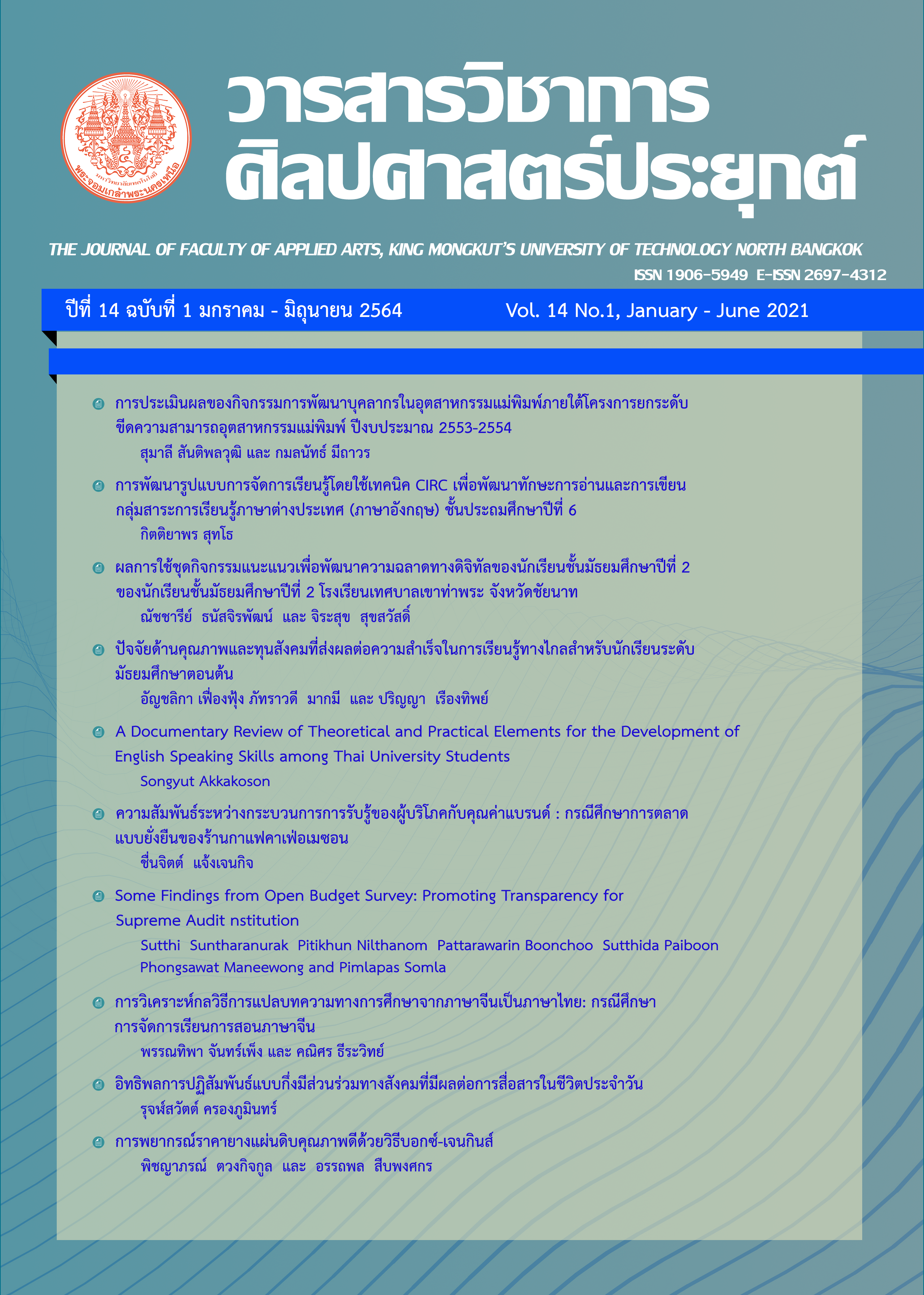ความสัมพันธ์ระหว่างกระบวนการการรับรู้ของผู้บริโภคกับคุณค่าแบรนด์ :กรณีศึกษาการตลาดแบบยั่งยืนของร้านกาแฟคาเฟ่อเมซอน
Main Article Content
บทคัดย่อ
ร้านกาแฟคาเฟ่อเมซอนได้นำแนวคิดการตลาดแบบยั่งยืนมาใช้ในรูปของการใช้ถ้วยไบโอคัพและการนำแนวคิดการหมุนเวียนทรัพยากรมาใช้ประโยชน์ซ้ำที่เรียกว่า Circular Living การศึกษาครั้งนี้มีวัตถุประสงค์เพื่อศึกษากระบวนการการรับรู้ของผู้บริโภคที่มีต่อการตลาดแบบยั่งยืนของร้านกาแฟคาเฟ่อเมซอน นอกจากนี้การศึกษาครั้งนี้ยังได้ประเมินคุณค่าแบรนด์ร้านกาแฟคาเฟ่อเมซอน และวิเคราะห์ความสัมพันธ์ระหว่างกระบวนการการรับรู้ของผู้บริโภคกับคุณค่าแบรนด์ร้านกาแฟคาเฟ่อเมซอน ทั้งนี้ใช้การวิจัยเชิงปริมาณโดยการสุ่มตัวอย่างแบบสะดวก จำนวน 500 ตัวอย่าง ผลการศึกษาพบว่า กลุ่มตัวอย่างรับรู้ต่อการตลาดแบบยั่งยืนของร้านกาแฟคาเฟ่อเมซอนในระดับมากในทุกองค์ประกอบของกระบวนการการรับรู้ จากการประเมินคุณค่าแบรนด์ของร้านกาแฟคาเฟ่อเมซอน พบว่าอยู่ในระดับมากที่สุดในด้านผลประกอบการของแบรนด์ในตลาด โดยเป็นผู้นำในธุรกิจร้านกาแฟในประเทศไทย ผลการทดสอบสมมติฐานพบว่า กระบวนการการรับรู้ของผู้บริโภคมีความสัมพันธ์กับคุณค่าแบรนด์ร้านกาแฟคาเฟ่อเมซอน ทั้งนี้ในการเพิ่มคุณค่าแบรนด์ร้านกาแฟคาเฟ่อเมซอนผ่านการตลาดแบบยั่งยืน ควรเพิ่มการมีส่วนร่วมจากผู้บริโภคในการกำหนดแนวคิดของการใช้วัสดุหรือของเสียในกระบวนการการผลิตและจำหน่ายกาแฟในร้านกาแฟคาฟ่อเมซอน
Article Details

อนุญาตภายใต้เงื่อนไข Creative Commons Attribution-NonCommercial-NoDerivatives 4.0 International License.
1.บทความที่ตีพิมพ์เป็นลิขสิทธิ์ของวารสารวิชาการศิลปศาสตร์ประยุกต์ การนำเนื้อหา ข้อความหรือข้อคิดเห็น รูปภาพ ตาราง ของบทความไปจัดพิมพ์เผยแพร่ในรูปแบบ ต่าง ๆ เพื่อใช้ประโยชน์ในเชิงพาณิชย์ ต้องได้รับอนุญาตจากกองบรรณาธิการวารสารอย่างเป็นลายลักษณ์อักษร
2.ข้อความที่ปรากฏในบทความแต่ละเรื่อง เป็นความคิดเห็นส่วนตัวของผู้เขียนแต่ละท่านไม่เกี่ยวข้องกับวารสารวิชาการศิลปศาสตร์ประยุกต์ และบุคลากร คณาจารย์ท่านอื่น ๆ ในวารสารฯ แต่อย่างใด ความรับผิดชอบองค์ประกอบทั้งหมดของบทความแต่ละเรื่องเป็นของผู้เขียนแต่ละท่าน หากมีความผิดพลาดใด ๆ ผู้เขียนแต่ละท่านจะรับผิดชอบบทความของตนเองแต่ผู้เดียว
เอกสารอ้างอิง
Aaker A. David. (1991). Managing Brand Equity. New York : The Free Press.
Aaker A. David. (1996). Measuring Brand Equity Across Products and Markets. California Management Review, 38(3), 105.
Alhaddad A. (2014). The Effect of Brand Image and Brand Loyalty on Brand Equity. International Journal of Business and Management Invention, 3(5), 28-32.
Beltz F.- M. and Peattie K. (2013). Sustainability Marketing (3rd ed.). Chichester.: John Wiley & Sons, Ltd.
Beig F. A. and Ahmad F. (2019). Impact of Brand Experience on Brand Equity of Online Shopping Portals: A Study of Select E-Commerce Sites in the State of Jammu and Kashmir. Global Business Review. Retrieved from https://journals.sagepub.com/toc/GBR/0/0
Crane, A. and Desmond J. (2002). Societal Marketing and Morality. European Journal of Marketing, 36(5/6), 548-69.
Hair, J.F., Black, W.C., Babin, J., & Anderson, R.E., & Tathan, R.L. (2006). Multivariate Data Analysis. New Jersey: Prentice Hall.
Keller K. L. and Swaminatham V. (2020). Strategic Brand Management: Building, Measuring, and Managing Brand Equity. Harlow: Pearson Education.
Kotler, P. and Keller K. L. (2016). Marketing Management (15th ed.). Harlow: Pearson Education.
Lindzev and Thomson. (1998). Handbook of Social Psychology (4th ed.). New York: Oxford University.
Leuthesser L., Kohli S. C. and Harich K. R. (1995). Brand Equity: The Halo Effect Measure. Europeon Journal of Marketing, 29(4), 57-66.
Shariq, M. (2018). Brand Equity Dimensions - A Literature Review. International Research Journal of Management and Commerce, 5(3), 312 - 330.
Yan, B. (2019). Research on the Influence of Customer Perceived Value on Brand Equity. American Journal of Industrial and Business Management, 9(3), 67-82.


